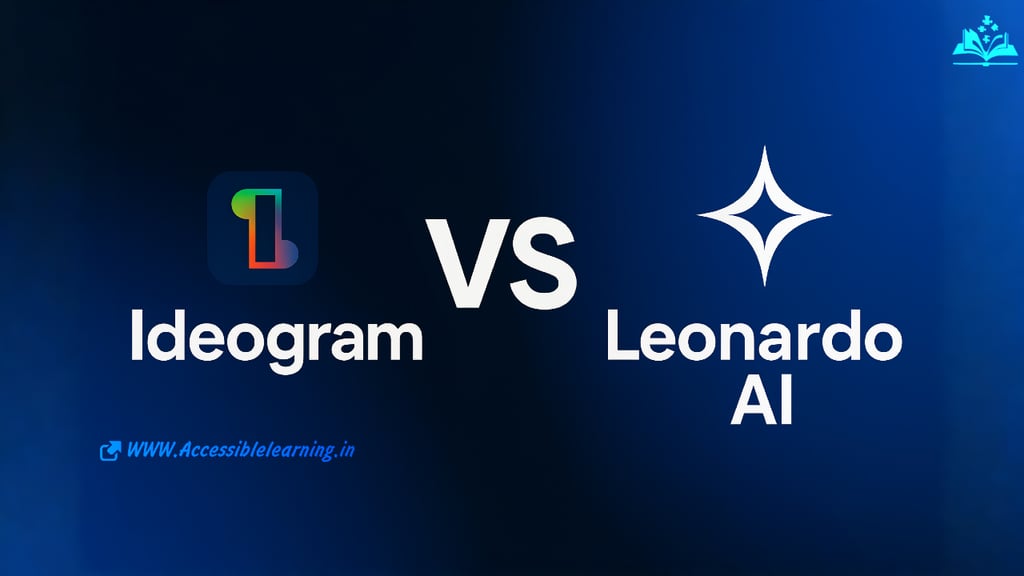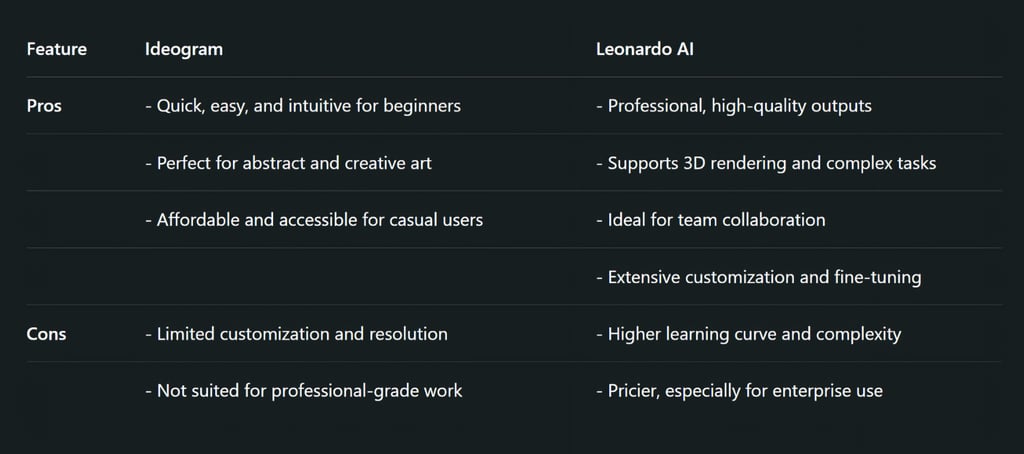
Ideogram vs Leonardo AI: Which Creative Platform is Right for You?
A comprehensive comparison between Ideogram and Leonardo AI, two powerful tools in the world of generative AI. This article explores their features, strengths, and weaknesses, helping you choose the best platform for your creative projects. Whether you're a casual user looking for easy-to-use design tools or a professional in need of advanced customization, find out which AI tool suits your needs.
AI ART TOOLSEDITOR/TOOLSAI/FUTUREEDUCATION/KNOWLEDGE
Sachin K Chaurasiya
4/29/20256 min read


The world of generative AI is moving at an incredible pace, particularly in the field of creative image and content generation. Two standout names that have caught the attention of artists, designers, and businesses alike are Ideogram and Leonardo AI. Both platforms promise to redefine the way we approach digital creation, offering unique features and capabilities. But how do they stack up against each other? This in-depth comparison will dive deeper into their core functionalities, strengths, and weaknesses, providing a comprehensive guide for anyone looking to harness the power of AI in their creative work.
What is Ideogram AI?
Ideogram is an emerging AI tool designed to revolutionize the way we create images. With a strong emphasis on text-to-image generation, Ideogram enables users to input descriptive prompts, and within seconds, it produces visually striking artwork, illustrations, and other creative visuals. The platform is designed for accessibility, allowing anyone—whether a novice or professional—to generate high-quality art in just a few clicks.
Advanced Features
High-Quality, AI-Generated Art: Ideogram excels in producing high-resolution images with minimal effort. It uses advanced natural language processing (NLP) to interpret textual input and turn it into detailed, often abstract, art.
Focus on Creative Freedom: Ideogram is designed to encourage creative freedom by enabling users to experiment with different prompts and art styles. The platform doesn't just churn out the same type of image repeatedly but offers the flexibility to explore various aesthetics, from realistic to surreal.
Real-Time Rendering: The platform’s real-time rendering system allows users to quickly test various ideas and refine their art in an iterative process, making it ideal for creators who want to experiment with different visual concepts.
User-Friendliness: Ideogram prides itself on offering a seamless, intuitive experience. Whether you're an illustrator looking to create inspiration or a content creator aiming for eye-catching visuals, the interface is designed to be user-friendly without sacrificing power.
Strengths
User-Friendly Interface—Ideal for beginners and casual creators.
Fast Rendering—Generates images quickly from text prompts.
Artistic Flexibility—Great for experimental and abstract artwork.
Affordable—Offers a freemium model with budget-friendly upgrades.
Weaknesses
Limited Customization—Not suitable for high-detail control.
Lower Resolution—Not optimized for print or high-end commercial use.
Less Professional Output—Best for casual and mid-level projects.
Use Cases
Social media graphics
Blog illustrations
Moodboards or concept sketches
Quick, creative visuals for personal or light commercial use


What is Leonardo AI?
Leonardo AI is a robust generative AI platform that blends the power of text-to-image generation with features geared toward professional content creators. The platform’s specialty lies in its ability to handle more complex tasks such as 3D model generation, intricate image adjustments, and a higher level of detail and customization than many other AI tools in the market. Leonardo AI is focused on providing users with cutting-edge tools for both individual and team-based creative endeavors.
Key Features
Precision and Detail: Unlike many AI tools that offer generic results, Leonardo AI is known for its precision. The platform can generate highly detailed images with incredible accuracy, making it a great choice for professionals who require intricate designs and detailed illustrations.
Collaborative Capabilities: One of Leonardo AI's most standout features is its emphasis on collaboration. Teams can work together on projects in real-time, which is an essential feature for agencies or creative teams looking to collaborate across departments.
High-Resolution Output: Leonardo AI is geared towards professional applications, with high-resolution image output suitable for print, digital media, advertising, and more. The AI ensures that every image generated is of superior quality, with the smallest of details accounted for.
3D Rendering and Customization: Leonardo AI goes beyond 2D designs, allowing users to create 3D models and incorporate a more complex range of customization options—ideal for game developers, animation studios, and product designers.
Strengths
High Precision & Detail—Produces professional-grade visuals.
Advanced Tools—Includes 3D rendering, customization sliders, and layer control.
Team Collaboration—Allows real-time project sharing and teamwork.
High-Resolution Output—Ideal for commercial, print, and production use.
Weaknesses
Steeper Learning Curve—May require time to fully understand.
Premium Pricing—More costly, especially at the enterprise level.
Heavier Interface—May feel overwhelming for casual users.
Use Cases
Game design and concept art
Product visualization and marketing assets
Film pre-production art
High-quality visuals for commercial campaigns or publishing


Ideogram vs Leonardo AI: A Deep Dive
Let’s explore some additional aspects to understand the finer nuances that differentiate these two AI platforms.
Learning Curve and User Accessibility
Ideogram: One of the most appealing aspects of Ideogram is its low learning curve. Anyone can start using the platform right away, regardless of their technical skills. It’s perfect for individuals or small teams that need a quick and easy way to generate stunning visuals without having to learn complex tools.
Leonardo AI: While Leonardo AI is still relatively intuitive, the breadth of its features and the level of control it offers means that there’s a slightly steeper learning curve. Users who want to fully leverage the platform's potential might need some time to get comfortable with all the features. However, this depth of control can be incredibly valuable for professionals who need high-quality and highly customizable designs.
AI Training and Algorithms
Ideogram: Ideogram's AI has been trained with a focus on artistic and creative outputs. This means it excels at generating artistic images, illustrations, and designs based on textual input. The AI is also constantly evolving to handle more nuanced language, enabling better results with more complex prompts.
Leonardo AI: Leonardo AI is built on advanced algorithms that go beyond text-based art. It incorporates machine learning models capable of handling 3D rendering and visual manipulation, making it a great tool for more specific and complex creative tasks. This focus on detailed imagery allows Leonardo AI to produce professional-level content that can be used in highly demanding industries.
Customization and Fine-Tuning
Ideogram: Ideogram allows for some degree of customization, especially when it comes to choosing artistic styles or adding simple tweaks. However, it tends to be more focused on artistic expressions, which may limit the degree of fine-tuning possible for users who need precise adjustments to images.
Leonardo AI: When it comes to fine-tuning and customization, Leonardo AI takes the lead. Its ability to adjust not only color palettes and textures but also 3D models, lighting, and scene compositions allows for more precise control over the final output. Whether you're designing a character for a game or creating marketing visuals, Leonardo AI allows users to perfect every minute detail.
AI-Generated Content Use Cases
Ideogram: Ideogram is perfect for quick sketches, concept art, and abstract creations. It’s widely used by content creators, bloggers, and small businesses who need to generate unique imagery for social media posts, blogs, and websites without the need for in-depth design expertise.
Leonardo AI: Leonardo AI is tailored more toward professional use cases. Whether it’s creating marketing materials, detailed 3D models, or high-quality illustrations for books, films, or advertising, Leonardo AI is a more powerful tool for industries that need scalable and sophisticated visual content.
Pricing and Subscription
Ideogram: Ideogram follows a more accessible pricing model, with a freemium plan available to get started. It’s ideal for casual users and smaller teams who don’t need enterprise-level features. Paid versions provide additional benefits such as higher resolution outputs and priority rendering times.
Leonardo AI: Leonardo AI offers tiered pricing, often starting with a free trial, followed by more expensive subscription plans for users who require professional-level tools and features. The pricing reflects the platform's advanced features, including high-resolution content generation, real-time collaboration, and 3D model generation.
Choosing between Ideogram and Leonardo AI ultimately depends on your goals and needs as a creator. If you’re an artist, blogger, or someone who needs quick, creative visuals with minimal setup, Ideogram is the go-to choice. It’s user-friendly, cost-effective, and produces fantastic results for casual projects.
However, if you’re a professional in need of detailed, high-resolution images, or if you're looking to experiment with 3D models and engage in team collaborations, Leonardo AI will better suit your needs. Its expansive features and ability to handle complex creative processes make it the perfect choice for businesses, studios, and high-level creatives.
By weighing the strengths of each platform and understanding your creative requirements, you’ll be able to make the best choice for your AI-driven content creation projects.
Subscribe To Our Newsletter
All © Copyright reserved by Accessible-Learning Hub
| Terms & Conditions
Knowledge is power. Learn with Us. 📚


